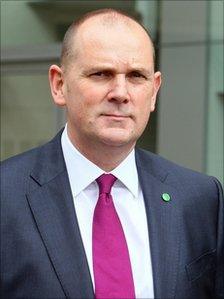Profile: Jim Gamble
- Published

Jim Gamble resigned because he wanted greater independence for Ceop
The resignation of Jim Gamble from his position as chief executive of the Child Exploitation and Online Protection Centre (Ceop) has been described by campaigners as a sad day for child protection.
It is testament to Mr Gamble's pivotal role in bringing the issue of child abuse to the top of the news agenda.
Ceop, under his watch, has become internationally recognised for the work it has done to track paedophiles using the web.
Home Secretary Theresa May's decision to merge Ceop with the National Crime Agency was a step too far for Mr Gamble, who had long campaigned for greater independence for the unit.
He felt very strongly that the work the unit was doing was so important that it needed to be a stand-alone department.
Ceop was set up in 2006 and has been the driving force behind a range of activities designed to track and prevent online paedophile activities.
It was able to track the exchange of photos and other materials related to child abuse on peer-to-peer networks, a previously unmonitored area of the web and one hugely exploited by paedophiles.
It also campaigned for an online panic button for social networking sites to allow young people to report abuse.
Bebo and MySpace installed the button last year and Facebook finally adopted it in July this year.
Mr Gamble is regarded as an expert in online crime but he began his career in Northern Ireland as an ordinary offline policeman.
Hunting paedophiles
He quickly rose through the ranks and became the head of Northern Ireland's anti-terrorist intelligence unit in Belfast.
Promoted to Deputy Chief Constable, Mr Gamble became the deputy director general of the National Crime Squad, which later merged with the Serious Organised Crime Agency.
In this role Gamble began to gain his reputation as the UK's foremost hunter of paedophiles, heading up Operation Ore, the UK's largest ever police investigation into who was viewing internet child abuse images.
The operation identified over 7,000 suspects and led to more than 2,000 convictions but it proved highly controversial.
There were criticisms that the net was hauling in too many innocent people and that some of those convicted had not viewed images of child abuse at all but were actually victims of identity theft.
But there is little doubt that the work started by Mr Gamble has led to some of the most predatory paedophiles being stopped in their tracks.
In interviews, Mr Gamble was always keen to stress that, while his work was embedded in the online world, the images and activities the unit monitored were real children who were being abused.
He was key to changing the way the media wrote about the issue, asking that headlines about "child porn" be dropped to reflect the true picture - that behind the grotesque images were hundreds of victims who could potentially be rescued.
- Published5 October 2010
- Published12 August 2010
- Published12 July 2010